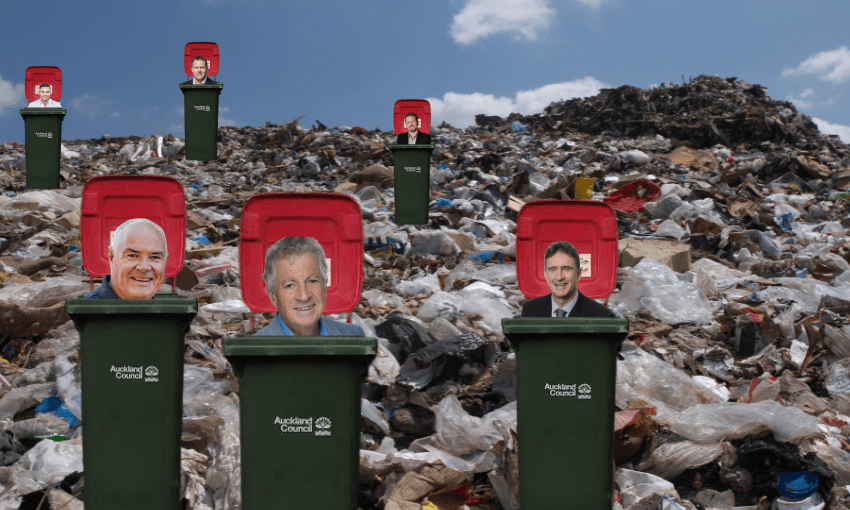We’re spending $5.5 billion on the City Rail Link. The council keeps trying to stop people accessing its stations or building things nearby.
About half an hour into Auckland Council’s debate on upzoning the city centre last week, mayor Wayne Brown looked up with a puzzled look on his face. He didn’t get why planners were telling his councillors they should vote to limit building heights on Karangahape Road. The area, he noted, was right next to a new train station on the rail line his council and the government have just spent $5.5 billion upgrading. “The whole point of this, as I understand, is to get more jobs and residents near this expensive railway, the City Rail Link. It doesn’t go far enough,” he said.
Brown would only get more confused. The new city centre zoning rules his councillors were voting on were an upgrade on the council’s current policy settings but still arguably illegal. They’d been served up to them by an independent hearings panel which was charged with giving effect to the National Policy Statement on Urban Development (NPS-UD), which commands councils to “realise as much development capacity as possible” in central areas. Despite that, the panel had proposed height limits in broad swathes of the city centre. Though they had been instructed not to consider views, the panellists wanted to protect the “visual permeability and connection as an expression of the built form [from] the city centre [to] the harbour”, which is another way of saying “we gotta consider views”.
Most councillors weren’t complaining though. Several actually wanted to limbo under an even lower bar of ambition. Not satisfied with just voting to stop some construction around the City Rail Link, they wanted more stringent limits in place. Albany councillor Wayne Walker led the charge, moving an amendment to add heritage protections to an empty gravel pit down the end of Karangahape Road. He won the backing of Waitematā councillor Mike Lee, who speechified incomprehensibly about short-term parking and “standing up to vested interests”.
At this point, something seemed to break inside Brown. He proposed an exchange: if Walker and Lee were successful in putting heritage protections on an empty site 600 metres from a new rail station, he would move to enable unlimited density near their homes in Whangaparāoa and on Waiheke Island. Councillors laughed nervously. Deputy mayor Desley Simpson started patting his shoulder and urgently making a cutting motion near her neck. But Brown wasn’t done. “To vote to have an empty site turned into a historic building is to demean the value of historic buildings, so you are actively working against preservation,” he said. “This is stupidity.”
Stupidity, maybe. Standard council operating procedure, certainly. Auckland Council is engaged in a war against its own City Rail Link on a surprisingly large number of fronts. In fact, the empty gravel pit Walker and Lee wanted to protect has already been protected once before. James Kirkpatrick Group had its proposal to build an 11-storey mass timber office block on the site knocked back in March after council planners and commissioners agreed it would “dominate” the streetfront and compromise the heritage values of the surrounding area — a point which would have been more convincing if the surrounding area wasn’t a Mobil station and a carpark.
Planners relented on that call after it was mocked by everyone from the housing minister to some loser at The Spinoff, but their council compatriots remain committed to other CRL-sabotaging measures. Over at Cross Street, directly outside the new Karanga-a-hape station, Auckland Transport has watered down pedestrian improvements that received broad community support because it wants to retain as much car access as possible. The changes would make more sense if it wasn’t for the fact tens of thousands of people will be walking through the area once the CRL opens, arguably creating a need for them not to be run over by a Ford Ranger.
If there’s a common thread in these decisions, it’s councillors and their officials failing to adequately plan for just how much the CRL is going to change the city. The project is adding the transport capacity of a 16-lane highway. Despite that, AT still hasn’t removed level crossings in places like Morningside, Mt Albert and Glen Eden, which may mean train frequencies are limited, or even in a small number of cases reduced, on some routes when it opens next year.
Meanwhile, the council has retained special character protections on much of the land in suburbs like Kingsland and Mt Eden, preventing thousands people from living within walking distance of the upgraded railway system they’ve just had billions of their tax dollars poured into.
At Thursday’s meeting, Brown repeated his threat to turn Waiheke into Dubai if his councillors stopped one more tall building from being built. Simpson patted his arm even more urgently.
The threats paid off. Brown won the battle. Walker and Lee were voted down, 20 to 2.
But afterwards, ahead of the substantive vote on whether to adopt the IHP’s plan, Waitakere councillor Shane Henderson lamented the lack of ambition for the city centre. “Places where you’re very close to train stations that we’ve invested billions of dollars into building and servicing, I just don’t know why, rationally, we would say to a developer that can make it work, that can provide the homes, ‘nah you’ve got to downzone it’. That’s weird to me,” he said.
When the meeting closed, Henderson told The Spinoff his colleagues were more interested in keeping as much of the status quo in place as possible than maximising the benefits of the CRL.
“There’s no vision,” he said. “The conversation tone is kind of ‘what can we get away with?’”
As it turns out, a lot. The council adopted the IHP’s recommendations with zero votes against and only Henderson abstaining. As the result was read out, North Shore councillor Chris Darby, an ardent special character advocate, could be heard on a hot mic saying “zero for the feds”. The council had pulled off another heist. The people who want to live and work near our largest ever public transport project will tally up their losses.





